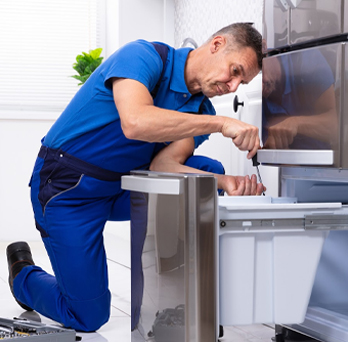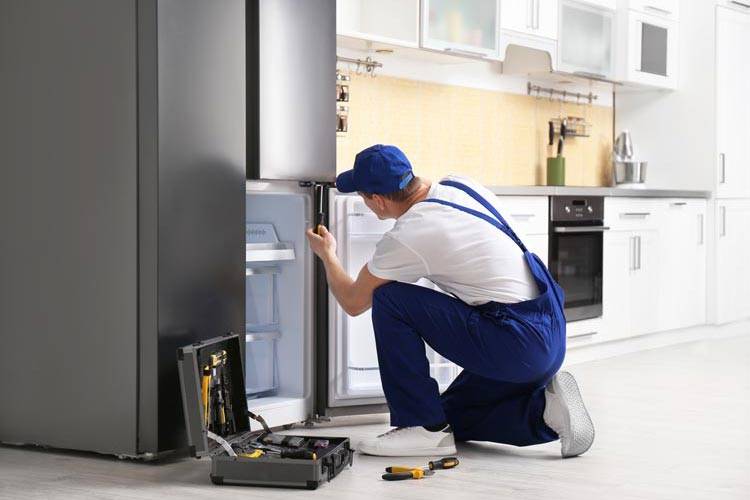Boost Your Home’s Value with Help from Emergency Sub-Zero Repair Dependable Refrigeration & Appliance Repair Service
Boost Your Home’s Value with Help from Emergency Sub-Zero Repair Dependable Refrigeration & Appliance Repair Service
Blog Article
The Ultimate Guide to DIY Appliance Repair Methods
From refrigerators to dish washers, recognizing just how to repair and repair these gadgets can save you time and money. Are you ready to discover important techniques that will empower you to deal with repair work confidently?
Understanding Common Device Troubles
When you rely on your home appliances, it can be frustrating when they suddenly stop functioning or break down. Comprehending usual appliance troubles can aid you fix problems efficiently. For example, if your fridge isn't cooling, examine the temperature level settings or evaluate the door seal for spaces. A malfunctioning washing equipment could be because of a stopped up drain filter or a broken belt.
If your stove isn't home heating, defective components or thermostat problems can be at fault. Dishwashers often experience troubles with drainage, so make certain the filter is clean and the drain pipe isn't kinked.
Also, listen for uncommon sounds; they commonly show mechanical problems. By identifying these indications, you can conserve time and potentially prevent pricey repair work. A little understanding goes a lengthy method in keeping your appliances, so stay educated to keep every little thing running efficiently.
Vital Tools for DIY Repairs
Before diving right into do it yourself appliance repair services, it is necessary to collect the right devices to guarantee the procedure goes smoothly. Begin with an excellent set of screwdrivers, including both flathead and Phillips, as they're crucial for opening most appliances. You'll also want a pair of pliers for grasping and turning cords or tiny components.
Don't neglect a multimeter; it helps you test electrical elements and identify problems properly. An outlet collection comes in handy for loosening up or tightening up bolts, while an utility blade can be useful for opening up or cutting cables packaging.
Lastly, think about having a flashlight accessible to brighten dark rooms inside your devices. With these important devices, you'll be well-equipped to tackle various repair work, conserving both time and cash. So, collect your gear and get prepared to roll up your sleeves!
Safety And Security First: Precautions to Take
Prior to you begin any type of home appliance repair work, it's crucial to focus on security. Make sure you use individual safety devices, disconnect the source of power, and keep your workspace arranged. These basic safety measures can help prevent accidents and assure a smoother repair service process.

Individual Safety Tools
Safety gear is a crucial part of any type of do it yourself appliance repair project. You should always put on safety and security goggles to shield your eyes from dust and particles. A tough set of gloves will shield your hands from sharp edges and hazardous materials. Consider making use of a mask if you're taking care of chemicals or dust, guaranteeing you take a breath safely while working. Steel-toed boots are also a clever selection, specifically when raising heavy appliances. Do not fail to remember to wear lengthy sleeves and trousers to shield your skin from possible injuries. By focusing on personal protective equipment, you'll considerably decrease the danger of injuries and mishaps. Bear in mind, being prepared with the ideal equipment maintains you safe and concentrated on finishing your repair service effectively.
Power Resource Interference
To guarantee a secure DIY home appliance repair, separating the source of power is important. Prior to you start any type of work, you must unplug the home appliance or turn off the breaker. This easy action stops electric shocks and assurances that you can focus on the repair work without fretting concerning unexpected activation. Constantly confirm that the home appliance is off by testing it with a voltage tester. If you're taking care of bigger appliances, like a washing machine or clothes dryer, see to it to protect the power cord and stay clear of any contact with water. Bear in mind, safety first! Once you're positive that the power is separated, you can with confidence wage your repair work, understanding you have actually taken the essential preventative measures to protect yourself.
Workplace Company
An efficient workplace can make all the difference in your DIY home appliance fixing task. Begin by clearing your workspace of mess to protect against distractions and crashes. Outline all your devices and products, grouping comparable items together for easy accessibility. Use a toolbox or coordinator to keep little parts their explanation like screws and washing machines had and labeled. Ensure you've obtained adequate lighting; it'll assist you see details clearly and decrease the risk of blunders. Do not fail to remember to maintain safety gear like gloves and safety glasses within reach. Have a trash bag handy to dispose of waste immediately. A tidy room not only enhances effectiveness but likewise keeps you risk-free while you work with your home appliance repair.
Step-by-Step Guide for Fridge Services
When your fridge starts acting up, it can be frustrating, yet taking on the trouble yourself can conserve you time and money. Examine for typical issues like temperature level fluctuations or unusual noises. For a noisy refrigerator, examine the follower and confirm it's not blocked.
If there's water pooling inside, inspect the door seals for damage or dust, and tidy them if needed. For ice accumulation, clear the defrost drain. Once you've attended to the issue, plug the refrigerator back in and monitor it for a couple of hours. If the problem lingers, you may require to change a damaged part, like the compressor or fan electric motor. Keep in mind, don't hesitate to seek advice from the handbook or seek specialist assistance if needed.
Taking Care Of Washing Equipment Concerns
Simply like fridges, cleaning makers can offer their own set of obstacles, however lots of concerns can be solved with a bit of troubleshooting. If your equipment will not start, check the power cord and confirm it's connected in.
If your clothing aren't getting clean, take into consideration the water level and cleaning agent type; using way too much cleaning agent can develop excess suds, affecting performance. For leaks, analyze the hoses for fractures or loosened links. Tightening up these can usually solve the issue. Normal upkeep, like cleansing the filter, can avoid numerous issues from emerging. Keep in mind, a little troubleshooting goes a long way in maintaining your cleaning equipment running smoothly.
Repairing Ranges and stoves
Just how can you fix typical problems with your stove or cooktop? Start by examining the power supply.
If your stove isn't heating, check the temperature level setups and validate the door seals snugly. A faulty burner can additionally be the culprit; you may need to change it if it's harmed.
For unequal cooking, rotate your frying pans and take into consideration using a stove thermostat to confirm precise temperatures. Lastly, if you listen to unusual sounds or scent gas, shut off the appliance instantly and get in touch with an expert. By adhering to these actions, you can identify and deal with several typical oven and cooktop issues efficiently.
Fixing Dishwashers Facilitated
When your dish washer begins acting up, it can be frustrating, but dealing with typical problems isn't as difficult as it appears. You'll learn detailed troubleshooting methods that will assist you pinpoint the problem, in addition to the important devices you'll need to tackle repairs on visit here your own. Allow's make repairing your dish washer a wind!
Usual Dishwashing Machine Problems
While dishwashing machines are created to make your life less complicated, they can sometimes run into typical concerns that leave you really feeling frustrated. If your Going Here dish washer's door won't latch, it could be an easy problem with the lock system or door seal. Resolving these concerns early can conserve you time and headache down the roadway.

Step-by-Step Troubleshooting
Before diving right into repairs, it's essential to recognize the specific concern your dish washer is encountering. If your dish washer will not start, check the power supply and door latch. By carefully dealing with each potential problem, you can determine the problem and take the necessary actions to repair it, making your dish washer feature like brand-new once again.
Necessary Repair Service Tools
When fixing your dishwashing machine,Having the right tools at your disposal can make all the distinction. Begin with a screwdriver set, as you'll often require both Phillips and flathead choices. A multimeter's important for diagnosing electric problems, while pliers can help you grasp and control various parts. Don't forget a pail or towels for any water splashes during fixings.
If you're tackling blockages, a drain snake or a wet/dry vacuum cleaner will be invaluable. You could also desire a degree to ensure your dish washer's correctly straightened. Lastly, security gear like handwear covers and safety glasses will certainly safeguard you while you function. With these crucial tools, you'll be fully equipped to take on any dish washer repair difficulty that comes your means.
Frequently Asked Concerns
If a Home Appliance Is Worth Repairing?, exactly how Do I Figure out.
To establish if a device's worth fixing, consider its age, repair service prices, and existing worth. If repairs exceed half the replacement cost, you might want to buy a brand-new version rather.
Can I Locate Substitute Parts Locally for My Device?
Yes, you can usually locate replacement components in your area for your home appliance. Check equipment stores, device repair service shops, or local classifieds. Do not forget to bring the version number to ensure you get the proper part!
What Common Mistakes Should I Prevent When Repairing Devices?
When fixing appliances, stay clear of rushing via diagnostics, neglecting safety and security preventative measures, or using wrong tools. Do not skip checking out manuals or seeing tutorials; they offer essential advice. Hold your horses and thorough to assure successful repair services and prevent additional damages.
For how long Does a Typical DIY Appliance Repair Work Take?
A regular DIY home appliance repair typically takes one to 3 hours, depending on the complexity. You'll desire to gather your tools and materials initially, and follow directions carefully to avoid unnecessary hold-ups.
Are There Any Kind Of Warranties for DIY Home Appliance Fixes?
When you take on DIY appliance repair services, service warranties typically don't cover your job. Nonetheless, some manufacturers might honor guarantees for components you change. Constantly inspect your device's service warranty terms before starting any type of repair services to prevent issues.
Prior to diving right into Do it yourself appliance repairs, it's crucial to collect the right devices to guarantee the procedure goes smoothly.Before you start any type of appliance repair work, it's vital to focus on security.To ensure a safe DIY home appliance repair service, detaching the power source is important.A well-organized job location can make all the distinction in your DIY appliance repair project. Constantly inspect your home appliance's warranty terms prior to beginning any type of repair work to prevent issues.
Report this page